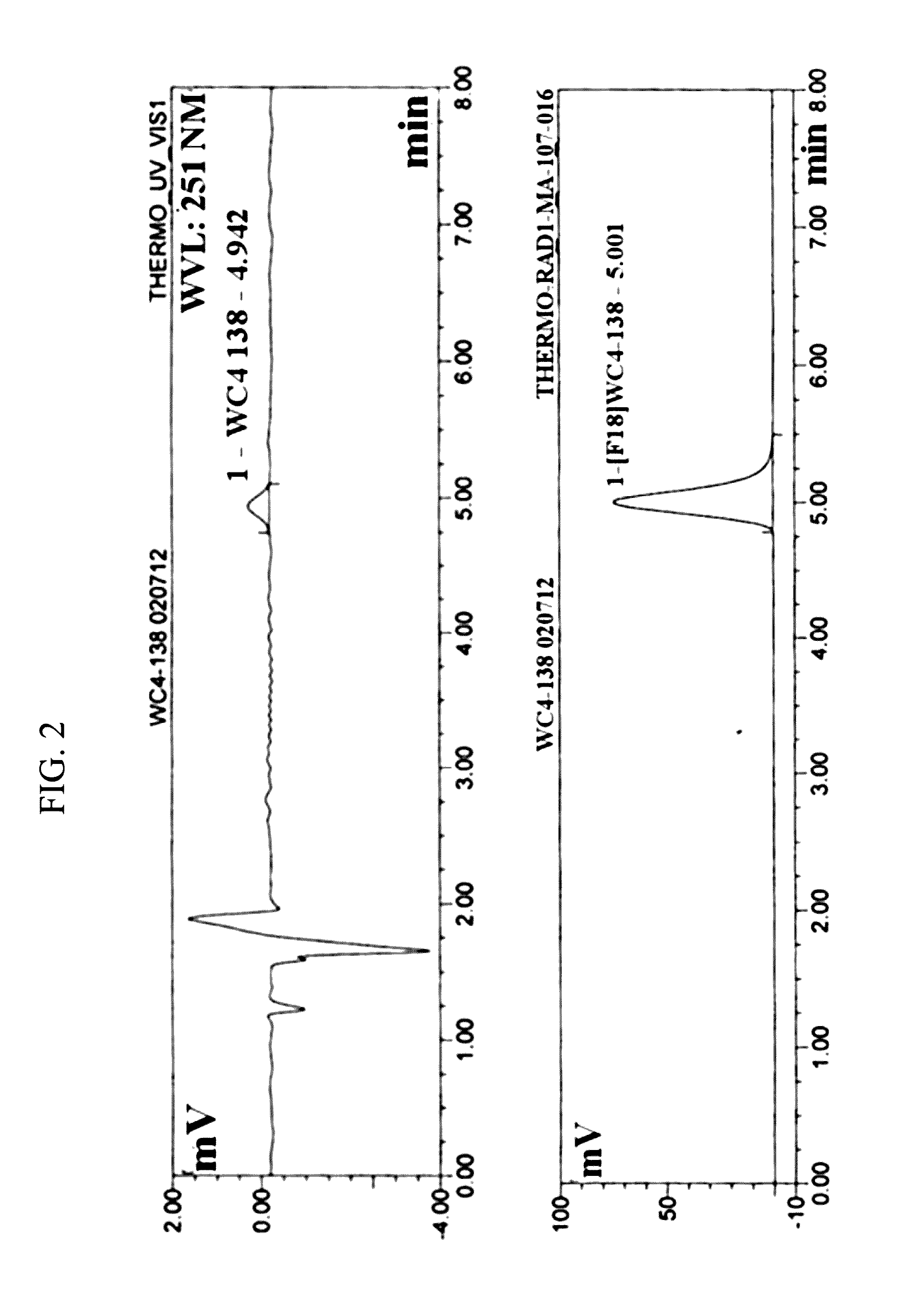Radiolabeled tracers for poly (adp-ribose) polymerase-1 (parp-1), methods and uses therefor
- Summary
- Abstract
- Description
- Claims
- Application Information
AI Technical Summary
Benefits of technology
Problems solved by technology
Method used
Image
Examples
example 1
[0029]This example illustrates synthesis of PARP-1 inhibitors. Compound numbers refer to Schemes 1 and 2, infra.
[0030]The syntheses of PARP-1 inhibitors of the present teachings are shown in Schemes 1 and 2. Methyl 2,3-diaminobenzate (5) was reacted with 4-(2-fluoroethyolxy)benoyl chloride in pyridine and dichloromethane to afford a mixture of intermediate 6a and the benzimidazole compound 6. After evaporation of the solvent, the mixture was refluxed with methanesulfonic acid in methanol to give 6. Then the methyl ester of 6 was compound to the amide compound 8 using ammonium in methanol. Similarly, the alkyne analog 9 was synthesized starting from 5 and 4-(prop-2-ynyloxy)benzoyl chloride. The triazole compound 10 was prepared by the copper(I) catalyzed click reaction of 2-fluoroehtylazide and 9 using CuSO4·5H2O and sodium ascorbate in DMF.
[0031]The tricycle compounds were synthesized from the diamine intermediate 11. Compound 11 was reacted with 4-(2-fluoroethoxy)benzoyl chloride i...
example 2
[0032]This example illustrates the synthesis of Methyl 2-(4-(2-fluoroethoxy)phenyl)-1H-benzo[d]imidazole-4-carboxylate (6). Compound numbers refer to Schemes 1 and 2, supra.
[0033]A mixture of methyl 2,3-diaminobenzoate 5 (500 mg, 3 mmol) and 4-(2-fluoroethoxy)benzoyl chloride (638 mg, 3.15 mmol) in CH2Cl2 (10 mL) and pyridine (10 mL) was stirred overnight at 23° C., After removal of the solvent under reduced pressure, the residue was dissolved in methanol (50 mL), and followed by addition of CH3SO3H (1 mL). After the mixture was refluxed tor 3 h, methanol was removed under reduced pressure, and the residue was dissolved in ethyl acetate (75 mL). The solution was washed with saturated Na2CO3 (50 mL), water (50 mL) and saturated NaCl (50 mL), and dried over Na2SO4. After evaporation of the solvent, the crude product was purified by silica gel column chromatography eluting with hexane-ethyl acetate (1:1) to afford 6 as white solid (686 mg, 73%), mp 134.2-134.6° C. 1H NMR (300 MHz, CDCl...
example 3
[0034]This example illustrates the synthesis of Methyl 2-(4-(prop-2-ynyloxy)phenyl)-1H-benzo[d]imidazole-d-carboxylate (7). Compound numbers refer to Schemes 1 and 2, supra.
[0035]Compound 7 was prepared according to the same procedure for compound 6 (Example 2), except using compound 5 (500 mg, 3 mmol) and 4-(prop-2ynyloxy)benzoyl chloride (613 mg, 3.15 mmol) as starting materials. The crude product was purified by silica gel column chromatography eluting with hexane-ethyl acetate (1:1) to afford 7 as white solid (724 mg, 79%), mp 176.0-176.8° C. 1H NMR (300 MHz, CDCl3) δ 10.58, 8.03 (d, J=9.0 Hz. 2H), 7.98 (d, J=8.1 Hz, 1H), 7.86 (d, J=7.8 Hz, 1H), 7.29 (t, J=8.1 Hz, 1H), 7.10 (d, J=9.0 Hz, 2H), 4.76 (d, J=2.4 Hz, 2H), 4.00 (s, 3H), 2.57 (t J=2.4 Hz, 1H), 13C NMR (75 MHz, CDCl3) δ 167.1, 159.4, 152.4, 144.9, 135.1, 128.2, 124.6. 124.3, 122.8, 121.8, 115.4, 113.0, 77.9, 76.0, 55.8, 52.1.
PUM
| Property | Measurement | Unit |
|---|---|---|
| Fraction | aaaaa | aaaaa |
| Capacitance | aaaaa | aaaaa |
| Fraction | aaaaa | aaaaa |
Abstract
Description
Claims
Application Information
 Login to View More
Login to View More - R&D
- Intellectual Property
- Life Sciences
- Materials
- Tech Scout
- Unparalleled Data Quality
- Higher Quality Content
- 60% Fewer Hallucinations
Browse by: Latest US Patents, China's latest patents, Technical Efficacy Thesaurus, Application Domain, Technology Topic, Popular Technical Reports.
© 2025 PatSnap. All rights reserved.Legal|Privacy policy|Modern Slavery Act Transparency Statement|Sitemap|About US| Contact US: help@patsnap.com



